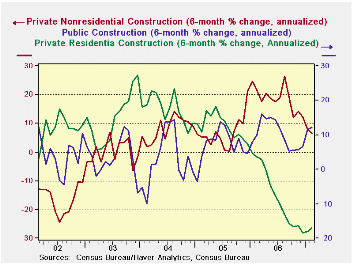 Global| Mar 30 2007
Global| Mar 30 2007U.S. Construction Also Rises…
Summary
Construction Put In Place $-MillionsPercentage Change as Noted1-Mo1-Mo SAAR3-Mo6-MOYr/YrShareTotal0.3%3.3%-9.4%-4.8%-2.4%100.0%Private0.2%2.6%-18.1%-9.5%-6.0%75.5% Residential-1.0%-11.0%-31.2%-17.0%-15.1%48.0% [...]
| Construction Put In Place $-Millions | ||||||
| Percentage Change as Noted | ||||||
| 1-Mo | 1-Mo SAAR | 3-Mo | 6-MO | Yr/Yr | Share | |
| Total | 0.3% | 3.3% | -9.4% | -4.8% | -2.4% | 100.0% |
| Private | 0.2% | 2.6% | -18.1% | -9.5% | -6.0% | 75.5% |
| Residential | -1.0% | -11.0% | -31.2% | -17.0% | -15.1% | 48.0% |
| Lodging | 2.6% | 35.8% | 46.2% | 20.9% | 45.4% | 1.9% |
| Office | -0.2% | -2.1% | 43.1% | 19.6% | 31.9% | 4.5% |
| Commercial | 1.8% | 23.3% | 9.2% | 4.5% | 8.6% | 6.8% |
| Transport | 1.6% | 21.6% | 24.2% | 11.5% | -0.7% | 0.8% |
| Communication | 6.8% | 119.4% | 96.9% | 40.3% | 16.8% | 1.6% |
| Power | 6.2% | 105.8% | -36.4% | -20.3% | 6.5% | 2.7% |
| MFG | 5.0% | 78.7% | 6.1% | 3.0% | 23.1% | 3.5% |
| Other | 0.6% | 7.9% | 9.5% | 4.6% | 9.8% | 5.8% |
| Public | 0.4% | 5.4% | 26.0% | 12.3% | 10.4% | 24.5% |
| Highway | 0.5% | 5.8% | 7.4% | 3.6% | 10.9% | 6.8% |
| Sewer | -0.2% | -3.0% | 36.9% | 17.0% | 8.9% | 1.8% |
| Water | -0.1% | -1.4% | -3.9% | -2.0% | 6.9% | 1.1% |
| Other | 0.5% | 6.7% | 37.3% | 17.2% | 10.6% | 14.8% |
 The chart on the left shows trends in the three main construction segments Private residential, Public and other private. These six month annualized growth rates show that nonresidential private spending is faltering, but still carrying positive growth. Private residential spending is stabilizing but still sinking at a steady 19% annualized rate of decline. Public spending is oscillating and growing at about a 12% pace.
The chart on the left shows trends in the three main construction segments Private residential, Public and other private. These six month annualized growth rates show that nonresidential private spending is faltering, but still carrying positive growth. Private residential spending is stabilizing but still sinking at a steady 19% annualized rate of decline. Public spending is oscillating and growing at about a 12% pace.
Although private residential spending shows signs of bottoming, this is in terms of a steep negative growth rate. Such ‘stabilization’ still implies subtraction from GDP. Meanwhile a major stabilizing factor, other private spending is decelerating rapidly. I suppose this not surprising given the way corporations have pulled back from, capital spending on equipment and software. Construction projects are certainly a little less malleable.Commentary Archive
| Construction Put In Place $-Millions | ||||||
|---|---|---|---|---|---|---|
| Percentage Change as Noted | ||||||
| 1-Mo | 1-Mo SAAR | 3-Mo | 6-MO | Yr/Yr | Share | |
| Total | 0.3% | 3.3% | -9.4% | -4.8% | -2.4% | 100.0% |
| Private | 0.2% | 2.6% | -18.1% | -9.5% | -6.0% | 75.5% |
| Residential | -1.0% | -11.0% | -31.2% | -17.0% | -15.1% | 48.0% |
| Lodging | 2.6% | 35.8% | 46.2% | 20.9% | 45.4% | 1.9% |
| Office | -0.2% | -2.1% | 43.1% | 19.6% | 31.9% | 4.5% |
| Commercial | 1.8% | 23.3% | 9.2% | 4.5% | 8.6% | 6.8% |
| Transport | 1.6% | 21.6% | 24.2% | 11.5% | -0.7% | 0.8% |
| Communication | 6.8% | 119.4% | 96.9% | 40.3% | 16.8% | 1.6% |
| Power | 6.2% | 105.8% | -36.4% | -20.3% | 6.5% | 2.7% |
| MFG | 5.0% | 78.7% | 6.1% | 3.0% | 23.1% | 3.5% |
| Other | 0.6% | 7.9% | 9.5% | 4.6% | 9.8% | 5.8% |
| Public | 0.4% | 5.4% | 26.0% | 12.3% | 10.4% | 24.5% |
| Highway | 0.5% | 5.8% | 7.4% | 3.6% | 10.9% | 6.8% |
| Sewer | -0.2% | -3.0% | 36.9% | 17.0% | 8.9% | 1.8% |
| Water | -0.1% | -1.4% | -3.9% | -2.0% | 6.9% | 1.1% |
| Other | 0.5% | 6.7% | 37.3% | 17.2% | 10.6% | 14.8% |
Robert Brusca
AuthorMore in Author Profile »Robert A. Brusca is Chief Economist of Fact and Opinion Economics, a consulting firm he founded in Manhattan. He has been an economist on Wall Street for over 25 years. He has visited central banking and large institutional clients in over 30 countries in his career as an economist. Mr. Brusca was a Divisional Research Chief at the Federal Reserve Bank of NY (Chief of the International Financial markets Division), a Fed Watcher at Irving Trust and Chief Economist at Nikko Securities International. He is widely quoted and appears in various media. Mr. Brusca holds an MA and Ph.D. in economics from Michigan State University and a BA in Economics from the University of Michigan. His research pursues his strong interests in non aligned policy economics as well as international economics. FAO Economics’ research targets investors to assist them in making better investment decisions in stocks, bonds and in a variety of international assets. The company does not manage money and has no conflicts in giving economic advice.






